Dogs
Using a dog crate effectively for a dog or puppy
Dogs are not only pack animals, 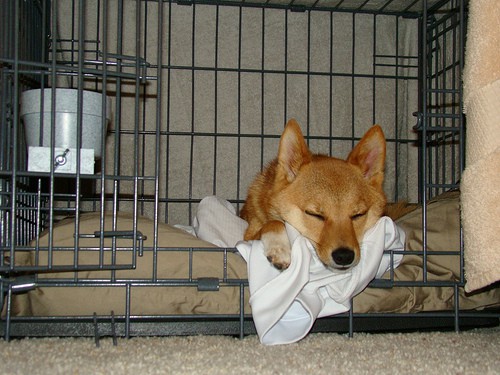 they also like to have their own space or den where they can rest or sleep. You have probably noticed that your dog will find his own place to sleep in a room, usually in a corner, under a table, on a pile of clothes in the laundry room, or on a rug in the hall. The natural instinct of having a safe place to sleep remains important to a dog even though they are not subjected to the same threats as his wild ancestors.
they also like to have their own space or den where they can rest or sleep. You have probably noticed that your dog will find his own place to sleep in a room, usually in a corner, under a table, on a pile of clothes in the laundry room, or on a rug in the hall. The natural instinct of having a safe place to sleep remains important to a dog even though they are not subjected to the same threats as his wild ancestors.
Should you use a dog crate?
For many dog owners who are concerned about their pet being left alone in their house, 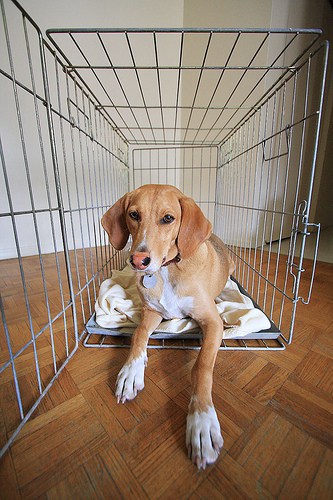 especially where their dog has developed some destructive behaviour will see a crate as a place that is safe for their pet. Once in the crate, a dog cannot chew furniture, cables, or other items that could harm him. Puppies can learn that the crate is a safe place, so it can be useful when travelling to crate him. This can relieve your puppy of stress and anxiety that can be associated with new experiences. If your dog is afraid of strangers, then placing him in a crate can also help relieve you and your dog from the stressful situation.
especially where their dog has developed some destructive behaviour will see a crate as a place that is safe for their pet. Once in the crate, a dog cannot chew furniture, cables, or other items that could harm him. Puppies can learn that the crate is a safe place, so it can be useful when travelling to crate him. This can relieve your puppy of stress and anxiety that can be associated with new experiences. If your dog is afraid of strangers, then placing him in a crate can also help relieve you and your dog from the stressful situation.
Where should you place a dog crate?
You should always try to place the crate in a place where your puppy or dog can get some quiet time. This may be in a corner of a room or in the room where you spend most of your time. This is because your dog is a pack animal and he wants to be close to you; otherwise, you may have to deal with issues associated with separation anxiety. A crate can be used as a day bed for your pet. At night, you can cover the crate to provide him with additional security.
Choosing a dog crate
Most dog crates or dog cages are rectangular and normally constructed of wire. You also find canvas and plastic crates for smaller dogs. Puppies love to chew, so you may find a wire crate beneficial, as they are less prone to damage by their razor sharp teeth.
Wire crates come in different gauges and designs. Most are collapsible, so you need to be able to erect the crate and ensure that it is sturdy when built to prevent accidents due to crushing or entrapment. No matter your choice of crate, you will be able to get the crate in different sizes. As the crate is a box once the doors are closed, it should be of sufficient dimensions to allow the puppy or dog to lie down and stretch out without touching the sides. Your dog should also be able to sit without hitting his head off the roof of the crate. As your puppy grows, you will need to find a larger crate.
Bear in mind that the purpose of the crate is to provide a secure environment for your dog, so it should not be too big either. An overly large crate may provide space for your dog to eliminate himself, which is not desired, as you want to encourage proper bowel and bladder control. This can be assisted by ensuring that the bedding in the crate covers the entire floor area. 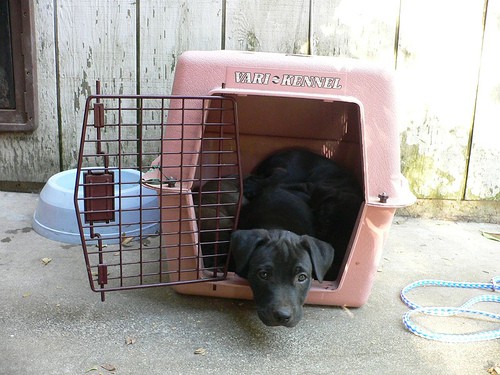
When to use a dog crate
A dog should become accustomed to a crate from an early age. A puppy will quickly learn to settle in a crate. If you have an older dog, it will probably take longer for him to learn to be happy when inside the crate.
A crate is useful when your puppy is going through the chewing stage, which can last until he is a year old. Some owners will not crate their dog beyond this period, as their dog will no longer want to chew things around the house. However, it is likely that the dog will still want to use the crate as a bed, but he will not have to be closed in it.
Teaching an older dog to use a crate
An older dog will take time to adjust to a crate. You should not just close your dog up and leave him to it. You should start by allowing your dog to enter and leave the crate filled with bedding and his favourite toys to entice him into it. You should praise and provide treats to him as he enters the crate and realises that the crate is a nice place to be. Before too long, your dog will enter the crate on his own to sleep. You should still leave the door open to begin with. 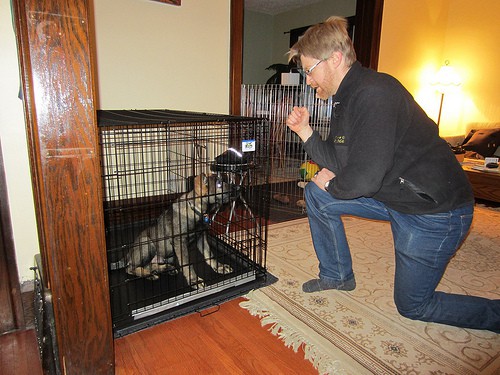
If you have small children, then make sure they do not play in the crate or an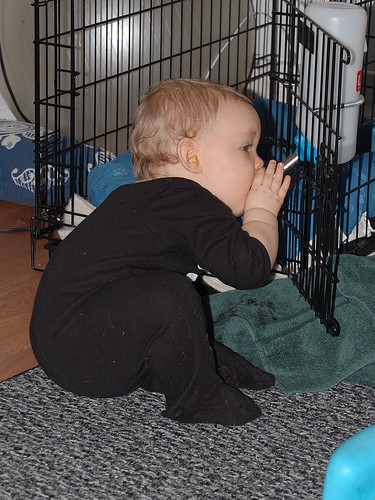




Hi, great article.. we can definitely use this article to educate our clients who buys dog cages from us in Malaysia.. Thanks for sharing.. Take care and keep it up..
Hi, Andrew. Glad that you find it useful! Thank you so much! 😀
It’s fantastic blog. really very good article on dog crate cover.Thanks